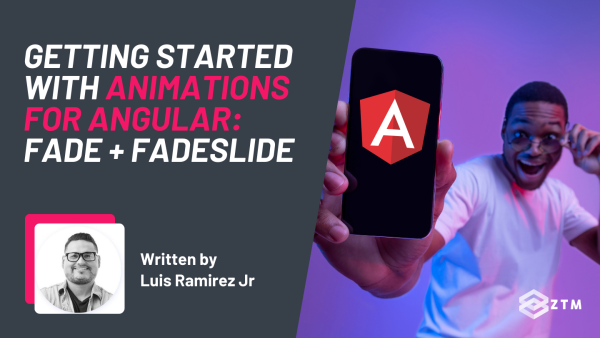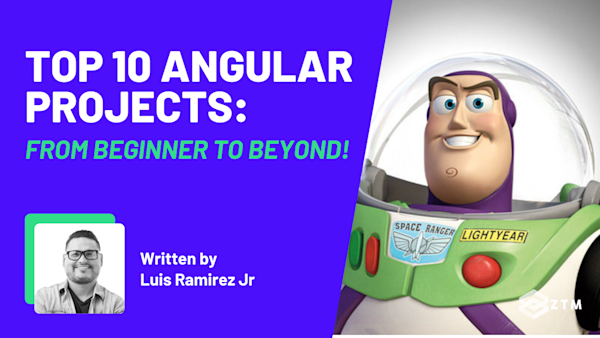So you've:
- Learned to code with Angular ✅
- Built a project portfolio with some amazing angular projects ✅
- Prepped for the tech interview ✅
You should be ready to sit down and get that job right? ❌
Hmm almost… Here’s the thing. Some interviewers may ask you some more specific Angular questions before they get into the actual coding and technical problem-solving.

They’re often basic concepts related to Angular and any other tech you’ll use on the job, so in theory, you should know the answers but they may have slipped your mind right now.
The good news? You can quickly revise for these questions before your interview, and make sure you ace it. (Because the last thing you want to happen is you fail on simple questions before getting into the actual part you’ve been training for right!?)
So what do you need to know?
Well, rather than make you sit down and try to learn 100+ basic Angular questions, I've put together the 25 most essential questions and answers that cover everything from fundamental concepts to advanced programming techniques.
Understand these and you'll be able to answer almost any Angular specific question they through at you - even if it's not on this list.
Huzzah!
Sidenote: If you find that you’re struggling with the questions in this guide, or perhaps feel that that you could use some more training and want to build some more impressive projects for your portfolio, then come and check out my complete Angular Developer course.
It’ll not only set you on the fast track to getting hired, but you’ll also blow away your interviewers with the level of work and knowledge you have.
No joke, this happens all the time. Interviewers see the quality of our ZTM student's projects and it's often way beyond what they need for their role, and so it’s a no-brainer for them to hire you!
With that out of the way, let’s get into the questions.
Basic Angular interview questions
#1. What is Angular?

Like I said, we start nice and simple, but you'll be surprised how many people will ask you this, so let's get the definitive answer down to give them. (The questions will get more difficult I promise!)
So the answer:
Angular is a TypeScript framework created by Google. It was primarily aimed at developing web applications, but it also offers the infrastructure necessary to build full-fledged, enterprise-level applications.
In fact, it comes with a vast range of features right out of the box, such as routing, dependency injection, end-to-end tooling, testing, form validation, reactivity, and much more.
Overall, Angular has everything you need to build scalable and maintainable web apps.
#2. What is the difference between AngularJS and Angular?
It's common to confuse Angular and AngularJS because they share similar names and both are built by Google, however, they're entirely different frameworks.
AngularJS was first introduced in 2010 for building client-side applications for the web. As its popularity grew, its many shortcomings were put into the limelight.
This is why Google decided to rewrite the framework from the ground up and renamed the newer version to Angular. The newer version ships with TypeScript, RxJS, and leverages modern APIs for building web applications.
Key differences between Angular and AngularJS include:
-
Dependency Injection (DI) - A pattern available in Angular for injecting dependencies into components and directives. AngularJS does not support DI
-
Template Syntax - Angular offers sugar syntax for binding properties or events. AngularJS uses various directives for accomplishing the same behavior
-
Mobile Support - Angular supports mobile devices while AngularJS does not
-
Programming Language - Angular applications are developed with TypeScript. On the other hand, AngularJS apps are developed with vanilla JavaScript with little to no support for TypeScript
-
Performance - Angular is known to score higher on most benchmarks compared to AngularJS, thanks to the efforts of the Google team for optimizing Angular for speed
-
Support - AngularJS is no longer supported or maintained. Angular constantly receives a major update every six months
#3. Why would someone use Angular over React?
React is a library that focuses on the view of an application.
However, features such as form validation, dependency injection, and testing are not available natively within React. This means that you have to seek out additional packages developed by the community to extend and get these features.
Whereas Angular does not suffer from these problems and new projects are scaffolded with these features.
tl;dr: While Angular is far more opinionated compared to other frameworks, you'll find yourself being far more productive since most decisions are made for you.
#4. What is TypeScript?

TypeScript is a language developed by Microsoft. It's a superset of JavaScript, which means it was not introduced to replace JavaScript but to build on top of its existing features.
Let me explain:
JavaScript is a dynamically typed language. These languages are notorious for allowing bugs to pass through without throwing an error because a variable's type can be unexpectedly changed.
TypeScript resolves this issue by enforcing stricter types, which makes it a strongly-typed language. (Types ensure reliability and consistency throughout your app.)
However, since TypeScript is not supported in most environments, it must be compiled into JavaScript. The compilation is offered by multiple packages and can easily be integrated into most front-end tooling.
#5. What is data binding?
In Angular, data binding is the mechanism by which the view (the HTML template) and the component class are connected and kept in sync.
There are two types of data binding in Angular:
- property binding, and
- event binding
Data binding in Angular allows you to connect properties and events of the view to properties and methods of the component class and keeps them in sync.
This allows you to separate the concerns of the view and the logic and makes it easy to update the view based on the data and user interactions.
#6. What is property binding?
Property binding is used to bind a property of a DOM element to a property of a component class.
It uses the syntax of [property]='expression' in the template, where "property" is the name of the DOM property and "expression" is the value to be bound.
For example, the following code binds the "value" property of an "input" element to the "name" property of a component class:
<input [value]="name" (input)="name = $event.target.value" />#7. What is event binding?
Event binding is used to bind an event of a DOM element to a method of a component class.
It uses the syntax of (event)='expression' in the template, where "event" is the name of the DOM event and "expression" is the method to be called.
For example, the following code binds the click event of a button element to the onClick method of a component class:
<button (click)="onClick()">Click me</button>In the component class, you can define the method:
export class MyComponent {
onClick() {
console.log("Button was clicked");
}
}In the example above, when the user clicks the button, the onClick method of the component class is called, and the message "Button was clicked" is logged to the console.
#8. What is two-way data binding?
Angular supports bidirectional communication between the component class and the view.
This is done by using the [(ngModel)] directive in the template.
For example, the following code binds the value attribute of an input element to the name property of a component class, and also updates the component's name property when the user types into the input field.
<input [(ngModel)]='name'>#9. Can you explain the difference between a service and a component in Angular?
In Angular, a service is a class that is used to share data and behavior across different parts of the application.
Services:
- Services are typically used to handle tasks such as data retrieval, processing, and storage, and they can be injected into components and other services as needed
- Services are typically singletons, meaning that there is only one instance of a service throughout the entire application
Components:
- A component, on the other hand, is a class that controls a portion of the user interface (UI) and can be used to define data that can be exposed to the view of the component
- Components are typically used to define the view and behavior of individual pages, sections, or elements within the application
- They can also be used to handle user interactions and to communicate with services to retrieve and update data
- Components are instantiated each time they are used, and they are typically organized into a tree-like structure with parent and child components
#10. Can you explain how dependency injection works?
Dependency injection (DI) is a design pattern that allows Angular to provide instances of a class (i.e., the dependencies) to other classes that need them.
This allows for a decoupled architecture, where classes are not tightly coupled to the implementation of their dependencies and can be easily tested and reused.
In Angular, dependency injection is implemented using the @Injectable decorator and the @Inject decorator.
The @Injectable decorator is used to mark a class as injectable, and the @Inject decorator is used to mark a constructor parameter as a dependency that needs to be injected.
Here is an example of how dependency injection works in Angular:
import { Injectable } from "@angular/core";
// Service that retrieves data from an API
@Injectable()
export class DataService {}
// Component that uses the DataService
export class MyComponent {
constructor(private dataService: DataService) {}
}In the example above, the DataService class is marked as injectable using the @Injectable decorator. The MyComponent class has a constructor that takes an instance of the DataService class as a parameter, which is marked as a dependency.
When Angular creates an instance of the MyComponent class, it uses the DataService class as a dependency and creates an instance of it, and then passes it to the MyComponent constructor.
This way, the MyComponent class doesn't have to worry about how to create or manage an instance of the DataService class; it just uses it. This makes the code more maintainable and testable.
#11. Can you explain how change detection works?
In Angular, change detection is the process by which the framework checks for changes in the component's data and updates the view accordingly.
Angular uses a unidirectional data flow, where the component's data flows down through the component tree, and any updates to the data trigger change detection.
Angular offers two change detection strategies, which are ChangeDetectionStrategy.Default and ChangeDetectionStrategy.OnPush.
#12. What are the differences between Angular's change detection strategies?
ChangeDetectionStrategy.Default: This is the default change detection strategy that Angular uses. It checks for changes in the component's data and all its child components on every browser event, such as mouse clicks, key presses, and network requests.
It checks for changes in the component's data by comparing the current value of the data with the previous value. This strategy is efficient for small applications but can be slow for large applications with many components.
ChangeDetectionStrategy.OnPush: This strategy is more efficient for large applications as it only checks for changes in the component's data when an event such as an@Input()value or an event from a DOM element occurs, instead of checking on every browser event.
It's essential to keep in mind that when using ChangeDetectionStrategy.OnPush, Angular will not detect changes that happen inside the component, such as changes to a property or a variable, unless they are caused by an event such as an @Input() value or an event from a DOM element.
#13. What are modules (NgModule)?
An ngModule is a way to organize the different parts of an Angular application, such as components, services, directives, and pipes.
An ngModule is a class decorated with the @NgModule decorator, which provides metadata that tells Angular how to compile and run the application.
An ngModule has several properties, such as:
declarations: A list of the components, directives, and pipes that belong to the moduleimports: A list of other modules that the module needs in order to work.providers: A list of services that the module providesbootstrap: A list of components that Angular should use as the root component(s) of the application
An ngModule allows you to organize the different parts of an Angular application and configure the application as a whole.
It also allows for lazy loading, which enables developers to load modules when they are needed instead of loading all modules at the start of the application.
#14. What are pipes?
Pipes are a way to transform or format data in a template. They are similar to filters in other frameworks and are denoted by the | character in a template.
They can be used to perform a variety of tasks, such as formatting a date, converting a string to uppercase, or calculating a mathematical expression.
Angular provides several built-in pipes such as date, uppercase, lowercase, currency, percent, and json.
You can also create your own custom pipe. Here is an example of how to use the built-in date pipe in a template:
<p>{{ today | date }}</p>In this example, the date pipe is used to format the today variable as a date.
You can also pass parameters to pipes. For example, the date pipe can take a format string as a parameter:
<p>{{ today | date:'MM/dd/yyyy' }}</p>In this example, the date pipe is used to format the today variable as a date using the specified format string.
It's important to keep in mind that pipes are pure by default, which means that they do not change the original data and return a new transformed value.
#15. What are the lifecycle hooks?
A component goes through a series of lifecycle stages as it is created, rendered, and destroyed.
Angular provides several lifecycle hooks that allow you to tap into these stages and perform specific actions at specific points in time.
(The lifecycle hooks are methods that are automatically called by Angular at certain points in the lifecycle of a component).
Here is a list of the most commonly used lifecycle hooks in Angular:
-
ngOnChanges(): This hook is called whenever an input property of the component is changed. It is called beforengOnInit()and after the firstngOnChanges() -
ngOnInit(): This hook is called after the component's data-bound properties have been initialized. It is a good place to put initialization logic -
ngDoCheck(): This hook is called during every change detection cycle, and it allows you to implement your own change detection logic -
ngAfterContentInit(): This hook is called after the component's content has been fully initialized. It can be used to access the content that is projected into the component's template -
ngAfterContentChecked(): This hook is called after the projected content has been checked for changes -
ngAfterViewInit(): This hook is called after the component's views, and child views have been fully initialized. It can be used to access the views that are created by the component's template -
ngAfterViewChecked(): This hook is called after the component's views and child views have been checked for changes -
ngOnDestroy(): This hook is called just before the component is destroyed. It can be used to clean up any resources allocated in the other lifecycle hooks
In summary, the lifecycle hooks in Angular are methods that are automatically called by the framework at specific points in the lifecycle of a component.
These hooks allow you to tap into the different stages of a component's lifecycle and perform specific actions at specific points in time, such as initializing data, updating the view, or cleaning up resources.
This can be useful for tasks such as fetching data, setting up subscriptions, or updating third-party libraries used by the component.
Advanced Angular interview questions

Still with me and haven't even broken a sweat yet? Well, let's get into some more advanced Angular interview questions then!
If you can answer these questions without looking at the answer first, you should feel confident about your chances in your interview.
#16. Can you explain the role of RxJS in Angular?
RxJS (Reactive Extensions for JavaScript) is a library for reactive programming in JavaScript.
It provides a way to work with asynchronous data streams, such as events, user input, and network requests, using a consistent and composable API.
In Angular, RxJS is used to handle asynchronous data streams, such as HTTP requests, user input, and route parameters. It allows you to handle these streams in a consistent and composable way, using a set of operators that can be used to transform, filter, and combine data streams.
#17. What are observables?
One of the key features of RxJS is the Observable, which represents a stream of data that can be observed and processed.
An Observable is similar to a Promise, but it can emit multiple values over time, instead of just one value. Observables can be created, subscribed to, and combined using operators.
Here is an example of how to use RxJS to handle an HTTP request in Angular:
import { HttpClient } from "@angular/common/http";
import { map } from "rxjs/operators";
export class MyComponent {
constructor(private http: HttpClient) {}
ngOnInit() {
this.http
.get("/api/data")
.pipe(map((data) => data.value))
.subscribe((value) => console.log(value));
}
}In this example, the http.get() method returns an Observable that represents the HTTP response.
The pipe() method is used to apply operators to the Observable, in this case, the map operator is used to extract the value property from the response.
The subscribe() method is used to subscribe to the Observable and handle the response.
RxJS also provides operators for handling errors, such as catchError, and operators for handling completion, such as finalize.
This allows you to handle errors and completion in a consistent way across different streams and to compose multiple streams together.
#18. How do you handle security in an Angular application, and what are some best practices for preventing common attacks?
Handling security in an Angular application involves protecting against various attacks, such as Cross-Site Scripting (XSS), Cross-Site Request Forgery (CSRF), and SQL injection.
Here are some best practices for preventing common attacks:
-
Input validation: Validate all user input on the client and server side to ensure that it is in the expected format and does not contain any malicious code. Use built-in Angular validation directives or a third-party library, like Angular Reactive Forms, to validate form inputs
-
Output encoding: Use Angular's built-in sanitization methods to encode all user input that is displayed in the view. This will prevent any malicious code from being executed in the browser
-
Use a Content Security Policy (CSP): A CSP is a security mechanism that helps to prevent XSS and other code injection attacks by defining a whitelist of sources of content that a browser should be allowed to load
-
Use security headers: Use security headers such as the
X-XSS-ProtectionandX-Content-Type-Optionsheaders to help prevent XSS and other code injection attacks -
Use HTTPS: Use HTTPS for all network communications to encrypt the data being sent and received, and to prevent man-in-the-middle (MITM) attacks
#19. Can you explain the difference between AOT and JIT compilation and the benefits of each?
AOT (Ahead-of-Time) and JIT (Just-in-Time) are two different compilation strategies in Angular.
AOT (Ahead-of-Time) compilation is a process where the Angular compiler runs during the build process and converts the Angular components, templates, and expressions into JavaScript before the application is run.
One of the main benefits of AOT, is that the browser does not need to do any additional compilation at runtime, so the application starts faster and runs more efficiently.
AOT also catches errors during the build process, which makes it easier to debug and deploy the application.
JIT (Just-in-Time) compilation is a process where the Angular compiler runs in the browser at runtime and converts the Angular components, templates, and expressions into JavaScript as the application is run.
With JIT, the build process is faster, but the application starts slower and consumes more resources, as the browser needs to perform additional compilation at runtime.
Let's dive a little deeper...
AOT (Ahead-of-Time) compilation benefits:
-
Faster load time: Since the compilation is done during the build process, the application starts faster
-
Better performance: Without the need for compilation at runtime, the application runs more efficiently
-
Catching errors at build time: AOT compilation catches errors during the build process, which makes it easier to debug and deploy the application
-
Better Security: AOT also eliminates the potential for malicious code injection by compiling the application ahead of time
JIT (Just-in-Time) compilation benefits:
-
Faster development: With JIT, the build process is faster, as there is no need to perform AOT compilation
-
Dynamic loading: JIT allows the application to dynamically load and compile the modules as they are needed, which can be useful for scenarios where the application loads different parts of the application based on the user's interactions
#20. What are router events?
Router events are emitted by the router at specific points in the navigation process.
These events can be used to track the state of the router and to perform specific actions at specific points in time.
Here are the most commonly used router events in Angular:
-
NavigationStart: This event is emitted when a new navigation starts -
NavigationEnd: This event is emitted when a navigation ends successfully -
NavigationCancel: This event is emitted when a navigation is canceled -
NavigationError: This event is emitted when a navigation error occurs -
RoutesRecognized: This event is emitted when the router parses the URL, and the routes are recognized
#21. What is lazy loading?
In Angular, lazy loading is a technique that allows you to load parts of the application only when they are needed, rather than loading all parts of the application at the start.
This can improve the application's startup time and reduce its memory usage, and is a key method for both improving user experience and hitting Core Web Vitals.
In Angular, lazy loading is implemented using the @NgModule decorator and the loadChildren property. The loadChildren property is used to specify the location of a module that should be lazily loaded. Here is an example of how to use lazy loading in an Angular application:
import { Routes, RouterModule } from "@angular/router";
const routes: Routes = [
{ path: "", redirectTo: "/home", pathMatch: "full" },
{ path: "home", component: HomeComponent },
{
path: "about",
loadChildren: import("./about/about.module").then((m) => m.ItemsModule),
},
];
@NgModule({
imports: [RouterModule.forRoot(routes)],
exports: [RouterModule],
})
export class AppRoutingModule {}In this example, the about route is configured to be lazily loaded using the loadChildren property.
The value of the loadChildren property is an arrow function that imports the module. The AboutModule is not loaded when the application starts. Instead, it is loaded only when the about route is activated by the user.
Lazy loading can be helpful to improve the performance of the application, especially in case of large applications with many routes.
Lazy loading can also improve the initial load time of the application.
#22. How do you handle internationalization and localization in an Angular application?
In Angular, internationalization (i18n) and localization (l10n) can be handled using the @angular/localize package.
Internationalization is the process of designing and developing an application that can be adapted to different languages and regions, without having to change the source code.
Localization is the process of adapting an application to a specific language and region, by providing translated strings and other locale-specific resources.
Here are the steps to handle i18n and l10n in an Angular application:
-
Add the
@angular/localizepackage to your application:ng add @angular/localize -
Use the
i18nattribute to mark translatable strings in your component's template and code:<h1 i18n>Hello, World!</h1> -
Extract the translatable strings from the application by running the following command:
ng extract-i18n. This command generates a file called messages.xlf containing the translatable strings in the application -
Translate the strings in the messages.xlf file into the desired languages
#23. What is DOM sanitizer?
The DOM sanitizer is a built-in service that is used to sanitize untrusted values that are going to be used in the DOM.
It helps to prevent Cross-Site Scripting (XSS) attacks by ensuring that any potentially dangerous values are properly encoded before they are inserted into the DOM.
The DOM sanitizer provides several methods for sanitizing different types of values, such as:
bypassSecurityTrustHtml()bypassSecurityTrustStyle()bypassSecurityTrustScript(), andbypassSecurityTrustUrl()
Each of these methods takes an untrusted value as an argument and returns a trusted value that can be safely used in the DOM.
It's important to keep in mind that the DOM Sanitizer is not a substitute for proper input validation and output encoding. It should be used in conjunction with other security measures to provide a comprehensive security strategy.
#24. What is Angular Universal?
Angular Universal is a technology that allows you to run Angular applications on a server, in addition to running them in a browser.
This allows you to pre-render the initial view of an application on the server and send it to the browser, which can improve the initial load time and search engine optimization (SEO) of the application.
Angular Universal uses the same codebase as a regular Angular application, but it runs on the server using Node.js.
This allows you to use the same components, templates, and services on the server and in the browser, which makes it easy to share code between the two environments.
Here are some benefits of using Angular Universal:
-
Improved load time: Since the initial view is pre-rendered on the server, the browser can display it immediately, which can significantly improve the load time of the application
-
Better SEO: Search engines can better crawl and index applications that are pre-rendered on the server, which can improve their visibility in search results
-
Better accessibility: Angular Universal can help to improve the accessibility of the application by providing a fully rendered view to users with JavaScript disabled
-
Improved user experience: Pre-rendering the application on the server can provide a faster and more responsive user experience
It's important to keep in mind that Angular Universal requires additional setup and configuration compared to a regular Angular application, as it also requires a Node.js server to pre-render the application.
This can add complexity to the deployment process, but the benefits are worth the extra effort.
#25. What is ‘Angular Material’ and why would you use it?

Angular Material is a UI component library for Angular that provides a wide range of pre-built, reusable UI components such as buttons, forms, cards, and more.
These components are designed to follow the Material Design guidelines developed by Google, which provide a consistent look and feel across all platforms.
Angular Material provides a set of reusable and accessible UI components that can be easily integrated into an Angular application.
These components are built on top of Angular's powerful template syntax and are fully customizable using CSS.
Some of the features of Angular Material include:
-
A wide range of pre-built UI components: Angular Material provides a wide range of pre-built UI components that can be easily integrated into an Angular application
-
Material Design guidelines: The components provided by Angular Material are designed to follow the Material Design guidelines, which provide a consistent look and feel across all platforms
-
Accessibility: Angular Material components are designed to be accessible, following the best practices for accessibility
-
Theming: Angular Material provides a way to customize the look and feel of the components using theming
-
Responsive design: Angular Material components are built with responsive design in mind, making it easy to create applications that look great on any device
So how did you do?
Did you get all 25 correct or did you stumble on any of them?
Important: If you know all these now but get nerves and forget them on the day, don’t freak out.
The interviewer mostly wants to know if you can talk through a problem, ask follow-up questions, be adaptable, and figure things out. It’s ok to say you don’t know or forgot right now, but make sure to email them later when you figure out the solution or remember the answer.
Don't waste your time trying to learn or memorize 50 or 100+ different questions either. Most interviewers care more about your thought process of how you talk about decisions you made on the Angular projects you've built rather than testing you on your ability to memorize random things that can easily be looked up (which is something all developers are doing every day).
Someone who puts in the effort to follow up and answer questions outside their scope of knowledge is much more likely to get hired than someone who gives up at the first sign of trouble!
Remember, luck is what happens when preparation meets opportunity. Just be sure to let me know in the Discord community when you get that new job!
You got this! And if you need a refresher, or want to up your Angular skills, be sure to check out my complete Angular Developer course.
Want a sneak peak?
I went ahead and uploaded the first 4 hours of the course below for free:
Check out more Angular content!
Check out some of my other Angular articles, guides and cheatsheets!
- A Beginner's Guide to Angular Lifecycle Hooks (With Code Examples)
- Mastering Angular Modals and Popups: A Step-by-Step Beginner’s Guide
- Beginners Guide To Angular ngOnChanges (With Code Examples)
- Beginners Guide To Angular ngFor (With Code Examples)
- Top 10 Angular Projects For Beginners And Beyond
- Getting Started With Animations For Angular: Fade + FadeSlide
- Top 5 Reasons Why You Should Learn Angular
- Angular Cheat Sheet




![Complete React Native Developer [with Hooks]](https://images.ctfassets.net/aq13lwl6616q/2gqVi4hhjq9vgvdh63UoKZ/0366c66ecd9f9e928745231d061dbb56/react_native_zero_to_mastery.png?w=600&h=337&q=50&fm=png&bg=transparent)




